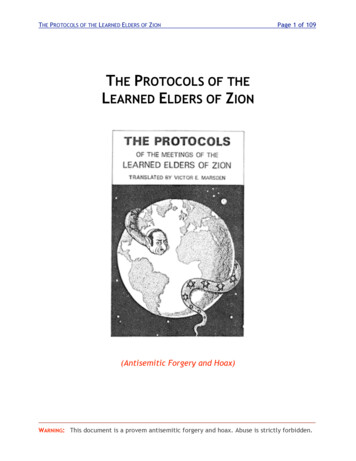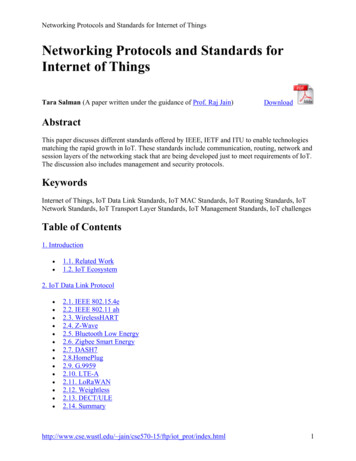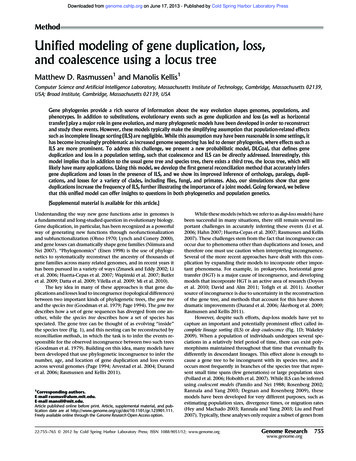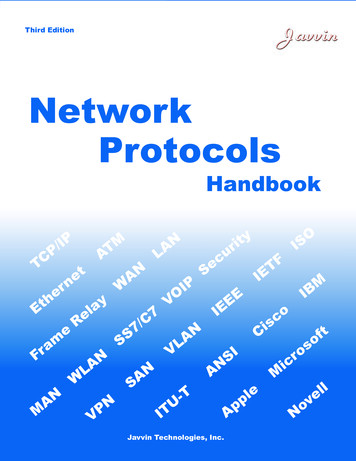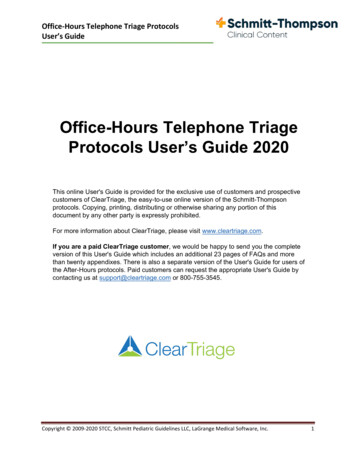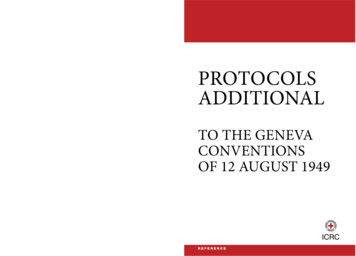
Transcription
Gene Knockout Protocols
M E T H O D SINM O L E C U L A RBIOLOGY1John M. Walker, SERIES EDITOR177. Two-Hybrid Systems: Methods and Protocols, edited by PaulN. MacDonald, 200!176. Steroid Receptor Methods: Protocols and Assays, edited byBenjamin A, Lieberman, 2001175. Genomics Protocols, edited by Michael P. Starkey andRamnath Elaswarapu, 2001i 74. Epstein-Barr Virus Protocols, edited by Joanna B. Wilsonand Gerhard H. W.May, 2001173. Calcium-Binding Protein Protocols, Volume 2: Methods andTechniques, edited by Hans J. Vogel, 2001172. Calcium-Binding Protein Protocols, Volume 1: Reviews andCase Histories, edited by Wans./. Vogel, 2001171. Proteoglycan Protocols, edited by Renato V. lozzo, 2001170. DNA Arrays: Methods and Protocols, edited by Jang 8.Rampat, 2001169. Neurotrophin Protocols, edited by Robert A. Rush, 2001168. Protein Structure, Stability, and Folding, edited by KennethP. Murphy. 2001167. DNA Sequencing Protocols, Second Edition, edited by ColinA. Graham and Alison J. M. Hill, 2001166. Immunotoxin Methods and Protocols, edited by Walter A.Hall, 2001165. SV40 Protocols, edited by Leda Raptis, 2001 '164. Kinesin Protocols, edited by Isabelle Vernos, 200!163. Capillary Electrophorcsis of Nucleic Acids, Volume 2:Practical Applications of Capillary Electmphoresis, edited byKeith R. Mitchelson and Jing Cheng, 2001162. Capillary Electrophoresis of Nucleic Acids, Volume 1: TheCapillary Electrophoresis System as an Analytical Tool, edited by Keith R. Mitchelson and Jing Cheng, 2001161. Cytoskeleton Methods and Protocols, edited by Ray H. Gavin,2001160. Nucicase Methods and Protocols, edited by Catherine H.Schein, 2001159. Amino Acid Analysis Protocols, edited by Catherine Cooper,Nicole Packer, and Keith Williams, 2001158. Gene Knockoout Protocols, edited by Martin J. Tymms andIsmail Kola, 2001157. Mycotoxin Protocols, edited by Mary W Trucksess and AlbertE.Pohland, 2001156. Antigen Processing and Presentation Protocols, edited byJoyce C. Solheim, 2001155. Adipose Tissne Protocols, edited by Gerard Ailhaud, 2000154. Ciiniuiiii Methods and Protocols, edited by RobertoBruzzone and Christian Giaume, 200!153. Neuropeptide Y Protocols, edited byAmbikaipakanBalasubramaniam, 2000152. DNA Repair Protocols: Prokaryotic Systems, edited byPatrick Vaughan, 2000151. Matrix Metalloproteinase Protocols, edited by Ian M. Clark, 2001150. Complement Methods and Protocols, edited by B. PaulMorgan, 2000149. The ELISA Guidebook, edited by John R. Crowther, 2000148. DNA-Protein Interactions: Principles and Protocols (2nded.), edited by Tom Moss, 2001147, Affinity Chromatography: Methods and Protocols, edited byPascal Bailon, George K. Ehrlich, Wen-Jian Fung, andWolfgang Berthold, 2000146. Mass Spectrometry of Proteins and Peptides, edited by JohnR. Chapman, 2000145. Bacterial Toxins: Methods and Protocols, edited by Otto Hoist,2000144. Calpain Methods and Protocols, edited by John S. Eke, 2000143. Protein Structure Prediction: Methods and Protocols,edited by David Webster, 2000142. Transforming Growth Factor-Beta Protocols, edited by PhilipH. Howe, 2000141. Plant Hormone Protocols, edited by Gregory A. Tucker andJeremy A. Roberts, 2000140. Chaperonin Protocols, edited by Christine Schneider, 2000139. Extracellular Matrix Protocols, edited by Charles Streuli andMichael Grant, 2000138. Chemokine Protocols, edited by Amanda E. I. Proudfoot, TimothyN. C. Wells, and Christine Power, 2000137. Developmental Biology Protocols, Volume HI, edited byRocky S. Tuan and Cecilia V. Lo, 2000136. Developmental Biology Protocols, Volume II, edited by /fociv5. Tuan and Cecilia W. ho, 2000135. Developmental Biology Protocols, Volume I, edited by RockyS. Tuan and Cecilia W.Lo, 2000134. TCell Protocols: Development and Activation, edited by KellyP. Kearse, 2000133. Gene Targeting Protocols, edited by Eric B. Kmiec, 2000132. Bioinformatics Methods and Protocols, edited by StephenMisener and Stephen A. Krawetz, 2000131. Flavoprotein Protocols, edited by S. K. Chapman and G. A.Reid, 1999130. Transcription Factor Protocols, edited by Martin J. Tymms,2000129. Integrin Protocols, edited by Anthony Howletl, 1999128, NMDA Protocols, edited by Min Li, 1999127. Molecular Methods in Developmental Biology: Xenopus andZebrafish, edited by Matthew Guille, 1999126. Adrenergie Receptor Protocols, edited by Curtis A. Machida, 2000125. Glycoprotein Methods and Protocols: The Mucins, edited byAnthony P. Corfield, 2000124. Protein Kinast Protocols, edited by Alaslair D. Reith, 2001123. In Situ Hybridization Protocols (2nd ed.), edited by Ian A.Darby, 2000122. Confocal Microscopy Methods and Protocols, edited byStephen W. Paddock, 1999121. Natural Killer Cell Protocols: Cellular and MolecularMethods, edited by KerryS. Campbell and Marco Colonna, 2000120. Eicosanoid Protocols, edited by Elias A. Lianos, 1999119. Chrnmatin Protocols, edited by Peter B. Becker, 1999118. RNA-Protein Interaction Protocols, edited by Susan R.Haynes, 1999117. Electron Microscopy Methods and Protocols, edited by M.A. Nasser Hajibagheri, 1999116. Protein Lipidation Protocols, edited by Michael H. Gelb, 1999
M E T H O D SINM O L E C U L A RBIOLOGYGene KnockoutProtocolsEdited byMartin J. TymmsNational Vision Research Institute of Australia,Carlton, Victoria, AustraliaandIsmail KolaCentre for Functional Genomics and Human Disease,Institute of Reproduction and Development, Monash University,Clayton, Victoria, AustraliaHumana Press m Totowa, New Jersey1
2001 Humana Press Inc.999 Riverview Drive, Suite 208Totowa, New Jersey 07512All rights reserved. No part of this book may be reproduced, stored in a retrieval system, or transmitted inany form or by any means, electronic, mechanical, photocopying, microfilming, recording, or otherwisewithout written permission from the Publisher. Methods in Molecular Biology is a trademark of TheHumana Press Inc.The content and opinions expressed in this book are the sole work of the authors and editors, who havewarranted due diligence in the creation and issuance of their work. The publisher, editors, and authors arenot responsible for errors or omissions or for any consequences arising from the information or opinionspresented in this book and make no warranty, express or implied, with respect to its contents.Cover illustration: Fig. 2 from Chapter 2, "Isolation and Maintenance of Primate Embryonic Stem Cells" byVivienne S. Marshall, Michelle A. Waknitz, and James A. Thomson.Cover design by Patricia F. ClearyFor additional copies, pricing for bulk purchases, and/or information about other Humana titles, contactHumana at the above address or at any of the following numbers: Tel: 973-256-1699; Fax: 973-256-8341;E-mail: humana@humanapr.com or visit our Website at www.humanapress.comPhotocopy Authorization Policy:Authorization to photocopy items for internal or personal use, or the internal or personal use of specificclients, is granted by Humana Press Inc., provided that the base fee of US S 10.00 per copy, plus US 00.25per page, is paid directly to the Copyright Clearance Center at 222 Rosewood Drive, Danvers, MA 01923.For those organizations that have been granted a photocopy license from the CCC, a separate system ofpayment has been arranged and is acceptable to Humana Press Inc. The fee code for users of the TransactionalReporting Service is: [0-89603-572-7/01 S10.00 00.25].Library of Congress Cataloging-in-Publication DataGene knockout protocols / edited by Martin J. Tymms and Ismail Kola.p.cm. --(Methods in molecular biology ; 158)Includes bibliographical references and index.ISBN 0-89603-572-7 (alk. paper)1. Gene targeting-Laboratory manuals. 2. Transgenic mice-Laboratory manuals. 1.Tymms, Martin J. II. Kola, Ismail. III. Methods in molecular biology (Clifton, N.J.) ; v.158.QH442.3 .G453 2000572.8'77-dc21
PrefaceAs the major task of sequencing the human genome is near completionand full complement of human genes are catalogued, attention will be focusedon the ultimate goal: to understand the normal biological functions of thesegenes, and how alterations lead to disease states. In this task there is a severelimitation in working with human material, but the mouse has been adopted asthe favored animal model because of the available genetic resources and thehighly conserved gene conservation linkage organization.In just of ten years since the first gene-targeting experiments were preformed in embryonic stem (ES) cells and mutations transmitted through themouse germline, more than a thousand mouse strains have been created. Theseachievements have been made possible by pioneering work that showed thatES cells derived from preimplantation mouse embryos could be cultured forprolonged periods without differentiation in culture, and that homologous recombination between targeting constructs and endogenous DNA occurred at a frequency sufficient for recombinants to be isolated. In the next few years themouse genome will be systematically altered, and the techniques for achieving manipulations are constantly being streamlined and improved.Recently new technologies have developed for inducible gene expression in transgenic mice that in combination with conventional gene targetingcan give temporal and tissue-specific expression. These advances have beenspurred on by the desire to study the function of genes that show an embryonic-lethal phenotype when deleted or "knocked out". Gene targeting in miceinitially concentrated on making gene knockouts or null mutations, but increasingly the technology is being used to create subtle point mutations to simulatehuman disease states.Gene Knockout Protocols brings together distinguished contributors withextensive experience in the gene targeting and mouse genetics fields. In linewith the successful format of Methods in Molecular Biology, the volume contains step-by-step protocols for the design of targeting constructs to protocolsfor the analysis of the mouse phenotype. Emphasis has been paid to the inclusion of other techniques used in mouse genetics that are relevant to researchers performing gene targeting. These include embryo transplantation, In vitro
viPrefaceES cell differentiation, creation of aggregation chimeras, mouse pathology, embryocryopreservation, and transplantation. Issues such as the use of existing mousemutation resources and the influence of genetic background and epigeneticeffects upon phenotype are also covered. We hope that Gene Knockout Protocols will be an invaluable source of proven protocols for those just enteringthe field of gene targeting, but also a valuable reference for researchers in theprocess of describing the phenotype of mutant mice.Martin J. TymmsIsmail Kola
ContentsPrefacevContributorsix1 Overview: Gene KnockoutsPaul J. Hertzog and Ismail Kola2 Isolation and Maintenance of Primate Embryonic Stem CellsVivienne S. Marshall, Michelle A. Waknitz,and James A. Thomson3 Gene Targeting in ES CellsThomas M, DeChiara4 Manipulating Mouse Embryonic Stem CellsLino Tessarollo5 Gene Targeting in a Centralized FacilityLouise D. Barnett and Frank Kontgen1111947,.656 The LoxP/CRE System and Genome ModificationTrevor J. Wilson and Ismail Kola837 Creation and Use of a Cre Recombinase Transgenic DatabaseAndras Nagy and Lynn Mar958 Choice of Mouse Strains for Gene TargetingMireille H. Lahoud, Trevor J. Wilson, and Paul J. Hertzog9 Isolation, Microinjection, and Transfer of Mouse BlastocystsAngelika Bonin, Susan W. Reid, and Lino Tessarollo10 Aggregation Chimeras: Combining ES Cells, Diploidand Tetraploid EmbryosMika Tanaka, Anna-Katerina Hadjantonakis,and Andras Nagy11 How to Study Pathologic Phenotypes of Knockout MiceRoderick T. Bronson12 Analysis of Hematopoietic Phenotypesin Knockout Mouse ModelsIvan Bertoncello and Brenda Williams,vii107121135155181
viiiContents13 Isolation of Embryonic Fibroblasts and Their Use in the In VitroCharacterization of Gene FunctionPaul J. Hertzog14 Influence of Genetic Background on Knockout Mouse PhenotypesL. Philip Sanford, Suhas Kallapur, llona Ormsby,and Thomas Doetschman20521715 Lineage Allocation During Early Embryogenesis: Mappingof the Neural Primordia and Application to the Analysisof Mouse MutantsGabriel A. Quintan, Bruce P. Davidson, and Patrick P. L. Tarn. 22716 Generation of Double-Knockout Embryonic Stem CellsHein te Riele, Conny Brouwers, and Marleen Dekker17 In Vitro Differentiation of Embryonic Stem Cells and Analysisof Cellular PhenotypesAnna M. Wobus, Kaomei Guan, and Uta Pich18 Embryonic Stem Cells in the Study of HematopoiesisFrancesca Lazner, Ismail Kola, Elizabeth Stadler,and Andrew G. Elefanty19 Interferon-lnducible ES Cell Expression SystemsLinda M. Whyatt and Peter D. Rathjen20 Transgenic Studies in the Mouse: Improving the TechnologyTowards a Conditional Temporal and Spatial ApproachSika Ristevski21 In Vivo Libraries of Large Insert Transgenic Micefor Genetic MappingDesmond J. Smith22 Epigenetic Effects on Transgene ExpressionEmma Whiteiaw, Heidi Sutherland, Margot Kearns, Hugh Morgan,Linda Weaving, and David Garrick23 Positional-Candidate Cloning of Genes from Mouse MutantsKaren B. Avraham24 Genetically Engineered Mice: Husbandry and ResourcesJohn J. Sharp, Carol C. Linder, and Larry E. Mobraaten25 Embryo Cryopreservation for Transgenic Mouse LinesJillian M. Shaw and Magosaburo KasaiIndex251263287301319335351369381397421
ContributorsB. AVRAHAM Department of Human Genetics and MolecularMedicine, Sackler School of Medicine, Tel Aviv University, Tel Aviv, IsraelLOUISE D. BARNETT The Walter and Eliza Hall Institute of Medical Research,Melbourne, AustraliaIVAN BERTONCELLO Trescowthick Research Laboratories, Peter MacCallumCancer Institute, Melbourne, AustraliaANGELIKA BONIN BASF Bioresearch Corporation, Worcester, MA.RODERICK T. BRONSON Human Nutrition Research Center, Boston, MACONNY BROUWERS Division of Molecular Carcinogenesis, The NetherlandsCancer Institute, Amsterdam, The NetherlandsBRUCE P. DAVIDSON Embryology Unit, Children's Medical ResearchInstitute, Sydney, AustraliaTHOMAS M. DECHIARA Regeneron Pharmaceuticals, Tarrytown, NYMARLEEN DEKKER Division of Molecular Carcinogenesis, The NetherlandsCancer Institute, Amsterdam, The NetherlandsTHOMAS DOETSCHMAN Department of Molecular Genetics, Biochemistryand Microbiology, University of Cincinnati College of Medicine,Cincinnati, OHANDREW G. ELEFANTY The Walter and Eliza Hall Institute of MedicalResearch, Melbourne, AustraliaDAVID GARRICK. Department of Biochemistry, University of Sydney,Sydney, AustraliaKAOMEI GUAN In Vitro Differentiation Group, IPK Gatersleben,Gatersleben, GermanyANNA-KATERINA HADJANTONAKIS Samuel Lunenfeld Research Institute,Mount Sinai Hospital, Toronto, Ontario, CanadaPAUL J. HERTZOG Centre for Functional Genomics and Human Disease,Monash University, Melbourne, AustraliaSUHAS KALLAPUR Department of Neonatology, Children's Hospital,Cincinnati, OHMAGOSABURO KASAI College of Agriculture, Kochi University, Kochi, JapanMARGOT KEARNS Department of Biochemistry, University of Sydney,Sydney, AustraliaKARENix
xContributors Centre for Functional Genomics and Human Disease, Instituteof Reproduction and Development, Monash University, Clayton, Victoria,AustraliaFRANK KONTGEN The Walter and Eliza Hall Institute of Medical Research,Melbourne, AustraliaMIREILLE H. LAHOUD Centre for Functional Genomics and Human Disease,Monash University, Melbourne, AustraliaFRANCESCA LAZNER Centre for Functional Genomics and Human Disease,Monash University, Melbourne, AustraliaCAROL C. LINDBR The Jackson Laboratory, Bar Harbor, MELYNN MAR Samuel Lunenfeld Research Institute, Mount Sinai Hospital,Toronto, CanadaVIVIENNE S. MARSHALL Wisconsin Regional Primate Research Center,University of Wisconsin, Madison, WILARRY E. MOBRAATEN The Jackson Laboratory, Bar Harbor, MEHUGH MORGAN Department of Biochemistry, University of Sydney,Sydney, AustraliaANDRAS NAGY Samuel Lunenfeld Research Institute, Mount Sinai Hospital,Toronto, Ontario, CanadaILONA ORMSBY Department of Molecular Genetics, Biochemistryand Microbiology, University of Cincinnati College of Medicine,Cincinnati, OHUTA PICH In Vitro Differentiation Group, IPK Gatersleben,Gatersleben, GermanyGABRIEL A. QUINLAN Embryology Unit, Children's Medical ResearchInstitute, Sydney, AustraliaPETER D. RATHJEN Department of Biochemistry, University of Adelaide,Adelaide, AustraliaSUSAN W. REID Neural Development Group, Mouse Cancer GeneticsProgram, NCI-Frederick Cancer Research and Development Center,Frederick MDSIKA RISTEVSKI Centre for Functional Genomics and Human Disease,Monash University, Melbourne, AustraliaL. PHILIP SANFORD Department of Molecular Genetics, Biochemistry andMicrobiology, University of Cincinnati College of Medicine, Cincinnati, OHJOHN J. SHARP The Jackson Laboratory, Bar Harbor, MEJILLIAN M. SHAW- Center for Early Human Development, Institute ofReproduction and Development, Monash University, Melbourne, AustraliaDESMOND J. SMITH Department of Molecular and Medical Pharmacology,UCLA School of Medicine, Los Angeles, CAISMAIL KOLA
Contributorsxi The Walter and Eliza Hall Institute of Medical Research,Melbourne, AustraliaHEIDI SUTHERLAND Department of Biochemistry, University of Sydney,Sydney, AustraliaPATRICK P. L.TAM Embryology Unit, Children's Medical Research Institute, Sydney, AustraliaMIKA TANAKA Samuel Lunenfeld Research Institute, Mount Sinai Hospital,Toronto, Ontario, CanadaHEIN IE RIELE Division of Molecular Carcinogenesis, The NetherlandsCancer Institute, Amsterdam, The NetherlandsLINO TESSAROLLO Neural Development Group, Mouse Cancer GeneticsProgram, NCI-Frederick Cancer Research and Development Center,Frederick MDJAMES A. THOMSON Wisconsin Regional Primate Research Center,University of Wisconsin, Madison, WIMICHELLE WAKNITZ Wisconsin Regional Primate Research Center, Universityof Wisconsin, Madison, WlLINDA WEAVING Department of Biochemistry, University of Sydney,Sydney, AustraliaEMMA WHITELAW Department of Biochemistry, University of Sydney,Sydney, AustraliaLINDA M. WHYATT Department of Biochemistry, University of Adelaide,Adelaide, AustraliaBRENDA WILLIAMS Trescowthick Research Laboratories, Peter MacCallumCancer Institute, Melbourne, AustraliaTREVOR J. WILSON Centre for Functional Genomics and Human Disease,Monash University, Melbourne, AustraliaANNA M. WOBUS In Vitro Differentiation Group, IPK Gatersleben,Gatersleben, GermanvELIZABETH STADLER
161. Cytoskeleton Methods and Protocols, edited by Ray H. Gavin, 2001 160. Nucicase Methods and Protocols, edited by Catherine H. Schein, 2001 159. Amino Acid Analysis Protocols, edited by Catherine Cooper, Nicole Packer, and Keith Williams, 2001 158. Gene Knockoout Protocols
